Allen Center
-
- ASNE And SNAME Members Tour Long Beach Naval Yard Complex Maritime Reporter, Aug 1978 #46
The June meeting of the Long Beach- Greater Los Angeles Section of The American Society of Naval Engineers was held jointly with the Los Angeles Metropolitan Section of The Society of Naval Architects and Marine Engineers.
The more than 160 participants who were members of each or both Societies, along with their families and invited guests, convened at the Allen Center Officer's Club at the Long Beach (Calif.) Naval Station where they boarded buses for a "drive-through" tour of the Long Beach Naval Station and the Long Beach Naval Shipyard complex.
Each bus had a tour guide who pointed out various buildings, berths, drydocks, ships, etc., and one of the outstanding landmarks viewed was the world's largest self-propelled floating crane, YD-171. This crane is one of four built at Bremerhaven, Germany, during World War II at an estimated cost of $3.5 million each, and captured by the British at Kiel in 1945. Of the four, one was sunk at Hamburg, one capsized in the English Channel as the British were attempting to move it to their homeland, one was assigned to the Russians, who moved the partially completed crane overland to Danzig, and it has not been heard of since, and the last one was very carefully handled in transiting the Atlantic, Panama Canal, and the final leg up the Pacific Coast to Long Beach.
The crane is of the level luffing type with a lifting capacity of 386 tons at a radius of 114 feet. The hull is fitted with three electrically driven, vertical axis, variable-pitch propellers, giving her a maximum speed of over 6 knots, and by varying the pitch individually on the three thrusters, the crane can be moved omni-directionally for any desired orientation. In 1969, she was repowered from 725-hp motors to 1,200-hp diesel engines driving 960-hp electric motors at a cost of $318,000, and is maintained in an active status at all times. She is truly a beautiful piece of machinery and has served well in both Naval and commercial lifting assignments over the past some 30 years.
The tour proceeded to alongside the USS Tarawa-LHA-1, where the buses unloaded the group for the tour of the newest and most versatile amphibious warfare ship in the U.S. Navy. Small groups were guided through the ship by men of the ship's crew, and to many of the Society members it was a much more familiar and meaningful visit than one usually experiences on such a tour.
Many had participated in the design, and more than just a few held positions of considerable responsibility during the conceptual and design phases of the ship's evolution.
Even though the physical ship was built in Pascagoula, Miss., she was conceived, developed and designed in the Greater Los Angeles area.
The USS Tarawa combines the functions and payloads of four amphibious force ships in that she carries helicopters, landing craft, tanks, jeeps, cargo and troops. Her flight deck extends the full 820 feet of her length, permitting simultaneous operation of nine helicopters. She also has a very large "wet well deck" in her stern which allows docking landing craft within the hull where they may be loaded with men, tanks, trucks, jeeps or cargo at the same time that similar materiel is being deployed by the helicopters up topside.
The movement of materiel within the ship from the storage areas to the flight deck and the "wet well deck" is accomplished by means of an elaborate system of conveyors, elevators and inclined ramps, affording her the capability of almost single-handedly conducting landing force operations.
Her electronics and communications systems are both extensive and versatile, and have as a heart of the electronics a system called Integrated Tactical Amphibious Warfare Data Computer System which, in addition to keeping track of the landing forces after leaving the ship, also tracks the enemy targets ashore. With this system the computer can direct, aim and fire the ship's guns and missiles, or can direct other supporting ships to do so. She can also maintain both air and surface traffic control for her own helicopters and landing craft and additionally those of the combat air patrols and the task force supply ships.
She has extensive medical facilities which include two main and two emergency operating rooms, two X-ray rooms, a blood bank, laboratories, and hospital wards with 300 beds, all staffed with competent doctors, nurses, technicians, specialists and corpsmen.
Fleet Admiral Chester W. Nimitz once said "The U.S. Navy's errands of mercy have saved more lives than all its guns have destroyed," and the USS Tarawa is by far better suited than any other Naval vessel to sustain this tradition. No matter what the disaster—be it typhoon, earthquake or hurricane— she has the capability to provide food, clothing, shelter, medical care, communications and transportation to aid the victims.
On completion of the inspection of the USS Tarawa, the group again boarded the waiting buses to return to the Allen Center where a no-host buffet luncheon was served.
-
 )
March 2024 - Marine Technology Reporter page: 26
)
March 2024 - Marine Technology Reporter page: 26FEATURE OCEANOGRAPHIC INSTRUMENTATION & SENSORS Kevin Mackay, TESMaP voyage leader and Center head of the South and West Paci? c Regional Centre of Seabed 2030. Kevin in the seismic lab at Greta Point looking at the Hunga Tonga-Hunga Ha’apai volcano 3D map completed with data from the TESMaP voyage
-
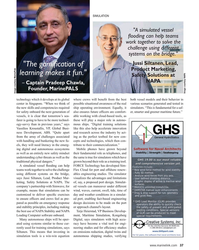 )
April 2024 - Maritime Reporter and Engineering News page: 37
)
April 2024 - Maritime Reporter and Engineering News page: 37SIMULATION "A simulated vessel ? ooding can help teams work together to solve the challenge using different systems on the bridge." – Jussi Siltanen, Lead, "The gami? cation of Product Marketing, learning makes it fun." Safety Solutions at NAPA – Captain Pradeep Chawla, Founder, MarinePALS Image
-
 )
April 2024 - Maritime Reporter and Engineering News page: 35
)
April 2024 - Maritime Reporter and Engineering News page: 35tables and a for training that enables this to be done safely. ABS has begun separate bridge wing console operated in virtual reality. to address this challenge through the utilization of simulation FORCE Technology’s upcoming DEN-Mark2 mathematical model release for its augmented reality SimFlex4 tug
-
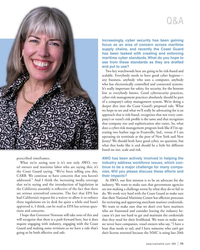 )
April 2024 - Marine News page: 11
)
April 2024 - Marine News page: 11now is it’s not only AWO, ves- industry address workforce issues, which con- sel owners and maritime labor who are saying this; it’s tinue to be a major challenge for many compa- the Coast Guard saying, “We’ve been telling you this, nies. Will you please discuss these efforts and CARB. We continue to have
-
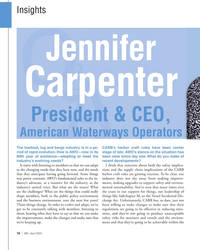 )
April 2024 - Marine News page: 10
)
April 2024 - Marine News page: 10to support safety and environ- industry’s united voice. But what are the issues? What mental sustainability. You’ve seen that many times over are the challenges? What are the things that could really the years in our support for things, our leadership of shape members, both in the public policy environment
-
 )
February 2024 - Maritime Reporter and Engineering News page: 44
)
February 2024 - Maritime Reporter and Engineering News page: 44Tech Files Latest Products & Technologies MarineShaft Yanmar Hydrogen MarineShaft specializes in urgent re- Fuel Cell AIP pair/replacement of damaged rudder and Yanmar Power Technology Co., Ltd. propeller equipment along with many (Yanmar PT), a subsidiary of Yanmar on-site repair services. MarineShaft
-
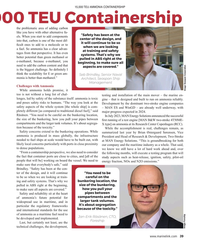 )
February 2024 - Maritime Reporter and Engineering News page: 39
)
February 2024 - Maritime Reporter and Engineering News page: 39at the e-methanol, because e-methanol, you beginning, to make sure all need to add the carbon content and that aspects are covered.” is the biggest challenge. So de? nitely I think the scalability for E or green am- Seb Brindley, Senior Naval monia is better than methanol.” Architect, Seaspan Ship
-
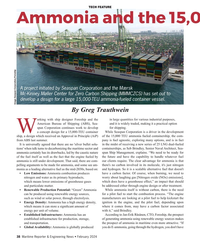 )
February 2024 - Maritime Reporter and Engineering News page: 38
)
February 2024 - Maritime Reporter and Engineering News page: 38TECH FEATURE Ammonia and the 15,00 A project initiated by Seaspan Corporation and the Mærsk Mc-Kinney Møller Center for Zero Carbon Shipping (MMMCZCS) has set out to develop a design for a large 15,000-TEU ammonia-fueled container vessel. Image Seaspan Corporation/Foreship By Greg Trauthwein orking with
-
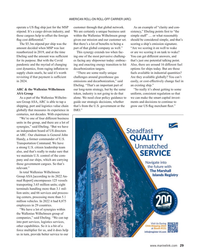 )
February 2024 - Maritime Reporter and Engineering News page: 29
)
February 2024 - Maritime Reporter and Engineering News page: 29industry, and We are certainly a unique business unit sistency,” Ebeling points ? rst to “the those cargoes help to offset the foreign within the Wallenius Wilhelmsen group simple stuff” … or what reasonably ? ag cost differential.” given our mission and our customer set. should be considered simple
-
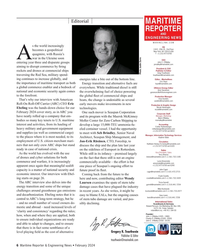 )
February 2024 - Maritime Reporter and Engineering News page: 6
)
February 2024 - Maritime Reporter and Engineering News page: 6tube [email protected] | +1.516.441.7254 energy transition and some of the unique damage cases that have plagued the industry Mike Kozlowski challenges around greenhouse gas emissions in recent years. As she writes, it might be [email protected] | +1.561.733.2477 and decarbonization. Ebeling
-
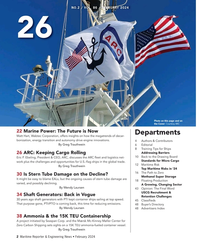 )
February 2024 - Maritime Reporter and Engineering News page: 2
)
February 2024 - Maritime Reporter and Engineering News page: 2Back to the Drawing Board Eric P. Ebeling, President & CEO, ARC, discusses the ARC ? eet and logistics net- Standards for Micro Cargo work plus the challenges and opportunities for U.S.-? ag ships in the global trade. 12 Maritime Risk By Greg Trauthwein Top Maritime Risks in ‘24 16 The Path to Zero 30
-
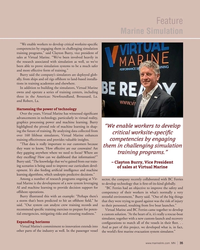 )
February 2024 - Marine News page: 35
)
February 2024 - Marine News page: 35Feature Marine Simulation “We enable workers to develop critical worksite-speci? c competencies by engaging them in challenging simulation training programs,” said Clayton Burry, vice president of sales at Virtual Marine. “We’ve been involved heavily in the research associated with simulation as well
-
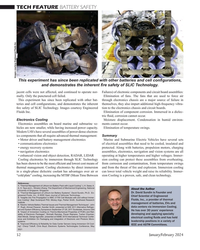 )
January 2024 - Marine Technology Reporter page: 52
)
January 2024 - Marine Technology Reporter page: 52TECH FEATURE BATTERY SAFETY Images courtesy Engineered Fluids Inc. This experiment has since been replicated with other batteries and cell con? gurations, and demonstrates the inherent ? re safety of SLIC Technology. jacent cells were not affected, and continued to operate nor- Failures) of electronic
-
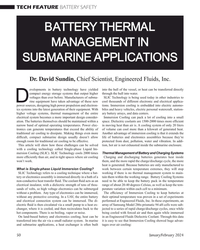 )
January 2024 - Marine Technology Reporter page: 50
)
January 2024 - Marine Technology Reporter page: 50enough room for traditional air cooling to be effective. protected from dust, pollution, water and vibration. In addi- This article will show how these challenges can be solved tion, hot air is not exhausted inside the submarine enclosure. with a cooling technology called Single-phase Liquid Im- mersion Cooling
-
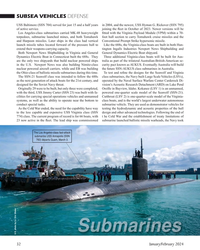 )
January 2024 - Marine Technology Reporter page: 32
)
January 2024 - Marine Technology Reporter page: 32SUBSEA VEHICLES DEFENSE USS Baltimore (SSN 704) served for just 15 and a half years in 2004, and the newest, USS Hyman G. Rickover (SSN 795) of active service. joining the ? eet in October of 2023. Newer versions will be Los Angeles-class submarines carried MK-48 heavyweight ? tted with the Virginia
-
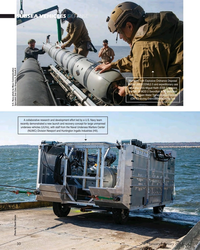 )
January 2024 - Marine Technology Reporter page: 30
)
January 2024 - Marine Technology Reporter page: 30SUBSEA VEHICLES DEFENSE Members from Explosive Ordnance Disposal Mobile Unit (EODMU) 5 and expeditionary sea base ship USS Miguel Keith (ESB 5) prepare the MK 18 MOD 2 Sword? sh to be deployed from the Open Water Transportation System (OWTS) during Exercise Noble Vanguard. U.S. Navy photo by Mass
-
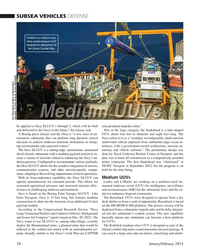 )
January 2024 - Marine Technology Reporter page: 28
)
January 2024 - Marine Technology Reporter page: 28a medium-sized un- sustained operational presence and increased mission effec- manned undersea vessel (UUV) for intelligence, surveillance tiveness in challenging undersea environments. and reconnaissance (ISR) for the submarine force and the ex- Orca is based on the Boeing Echo Voyager XLUUV. Like plosive
-
 )
January 2024 - Marine Technology Reporter page: 27
)
January 2024 - Marine Technology Reporter page: 27vehicle deployed from submarine large ocean interfaces, with a government-owned architecture, mission autonomy and vehicle software. Photo by Richard Allen, Naval Undersea Warfare Center Division Newport www.marinetechnologynews.com 27 MTR #1 (18-33).indd 27 1/31/2024 2:24:34 P
-
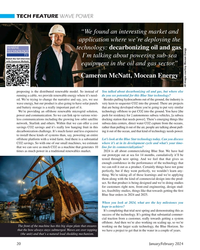 )
January 2024 - Marine Technology Reporter page: 20
)
January 2024 - Marine Technology Reporter page: 20, savings CO2 savings and it’s really low hanging fruit in this rather than pulling it out of the air, people are talking about pull- decarbonization challenge. It’s much faster and less expensive ing it out of the ocean, and that kind of technology needs power. to install these kinds of systems than,
-
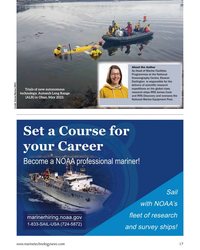 )
January 2024 - Marine Technology Reporter page: 17
)
January 2024 - Marine Technology Reporter page: 17About the Author As Head of Marine Facilities Programmes at the National Oceanography Centre, Eleanor Darlington is responsible for the delivery of scienti? c research expeditions on the global class Trials of new autonomous research ships RRS James Cook technology, Autosub Long Range and RRS
-
 )
January 2024 - Marine Technology Reporter page: 14
)
January 2024 - Marine Technology Reporter page: 14INSIGHTS SCIENCE RESEARCH MANAGEMENT © Who is Danny/AdobeStock PAVING THE WAY IN INTERNATIONAL SCIENCE RESEARCH MANAGEMENT Dr. Eleanor Darlington, Head of Marine Facilities Programs at the National Oceanography Centre (NOC), discusses how NOC is paving the way in international science research
-
 )
January 2024 - Marine Technology Reporter page: 8
)
January 2024 - Marine Technology Reporter page: 8calling the ? rst ships. With these countermeasures in mind, small actors are true drone war, continues to showcase and validate now turning to the challenging, opaque undersea domain. Dthe combat effectiveness of small, lethal, expend- In Ukraine, wartime development of weaponized, combat able vehicles
-
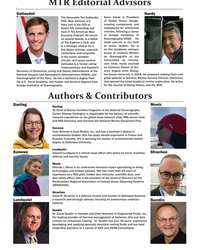 )
January 2024 - Marine Technology Reporter page: 6
)
January 2024 - Marine Technology Reporter page: 6MTR Editorial Advisors Gallaudet Hardy The Honorable Tim Gallaudet, Kevin Hardy is President PhD, Rear Admiral, U.S. of Global Ocean Design, Navy (ret) is the CEO of creating components and Ocean STL Consulting and subsystems for unmanned host of The American Blue vehicles, following a career
-
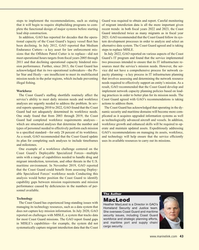 )
January 2024 - Maritime Reporter and Engineering News page: 43
)
January 2024 - Maritime Reporter and Engineering News page: 43for completing such analyses to include timeframes uses its available resources to carry out its missions. and milestones. One example of a workforce challenge centered on the Coast Guard’s Deployable Specialized Forces—multiple units with a range of capabilities needed to handle drug and migrant interdiction
